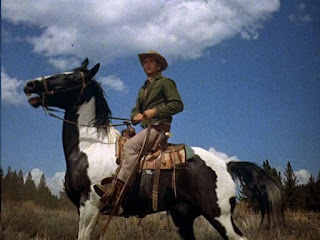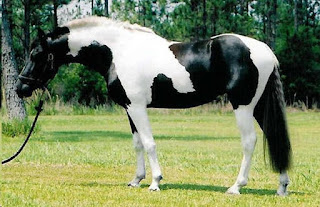This month I'm writing about my favorite breed of horse, the Pinto which Grey Wolf rode in Trail To Destiny, Book 1 of my Wheels of Destiny Trilogy.
In my stories, I consider the hero or heroine's horse as much a
secondary character as the people are! Look back on lots of TV and
movie westerns and you'll remember the names of so many horses the main
characters rode. One of the first Pintos in movie westerns dates back to
the early 1920's with a horse named Fritz owned by William Hart. He
performed with Hart in multiple movies and remained a beloved companion into
the actor's retirement.
Another famous Pinto was Tonto's horse, Scout. And can't
forget to mention Bonanza and Little Joe's Pinto, Cochise.
It is believed that the Pinto patterns may have arrived in Europe via the
Arabian strains, as Pinto markings appear in ancient art throughout the Middle
East. However, evidence of the more dominant Tobiano pattern among the wild
horses of the Russian Steppes suggests the introduction of Pinto coloring to
Europe possibly as early as during the Roman Empire.
After the arrival of these European horses, great wild herds infused with the flashy color patterns we know today began to develop across America, eventually to be domesticated by the Native American. The white man continued to import many of the well-established and stylish European breeds as his foundation stock. Over time, however, with the civilization of the Native American and the white man's migration to the frontier, it often became necessary to cross these fancy, but less suitable breeds of the Eastern seaboard with the wild mustang stock to increase size and attractiveness as well as availability of a horse better suited to the strenuous working conditions of the day.
This Western-bred horse became a fixture of America,
especially the uniquely marked Pinto whose colorful presence in parades and
films always added a little extra glamour.
What are the Pinto patterns and how do they differ? There
are two recognized Pinto color patterns:
1) TOBIANO (Toe-bee-ah'-no) appears to be white with large spots
of color, often overlapping on animals with a greater percentage of color than
white. Spots of color typically originate from the head, chest, flank, and
buttock, often including the tail. Legs are generally white, giving the
appearance of a white horse with large or flowing spots of color. Generally,
the white crosses the center of the back or topline of the horse. It is
considered necessary to have a Tobiano parent to achieve a Tobiano foal.
2) OVERO(O-vair'-o) appears to be a colored horse with
jagged white markings usually originating on the animal's side or belly,
spreading toward the neck, tail, legs, and back. The color appears to frame the
white spots. Thus, an Overo often has a dark tail, mane, legs, and backline.
Bald or white faces often accompany the Overo pattern. Some Overos show white
legs along with splashy white markings, seemingly comprised of round, lacy
white spots. White almost never crosses the back or topline. A horse of Pinto
coloration descendant from two solid colored parents of another typically solid
colored pure breed is called a "crop-out" and is of the Overo
pattern.
The Pinto Horse Association of America was
formed in 1956 although the bloodlines of many Pintos trace three or four
generations before that date. Choice, versatility and achievement for the breed
that offers something for everyone is what the Pinto Horse Association has to
offer.
The Pinto horse is a color breed in contrast to most other breeds which are defined by their genetic ancestry. In America, the Pinto is regarded as a proper breed. The Pinto coloration may occur in any breed or specific conformation. However, the Pinto Horse Association of America does not accept horses with Appaloosa, Draft, or mule breeding or characteristics.
In the American west, the Pinto has traditionally been
regarded as a horse the American Indian favored as a war horse since its
coloring provided a natural camouflage.
This
photograph shows the difference between a Pinto
horse
(left) and a leopard-spotted Appaloosa (right).
The Pinto does not have consistent conformation
since it is bred for color. When the darker color is black, the horse is often
described as Piebald. When the darker color is anything but black, the horse is
described as Skewbald. Pintos may be from a variety of breeds, ranging from
Thoroughbred to Miniatures.
What is the difference between Pintos and Paints? Of the questions posed to the PtHA, this is invariably the most frequently asked. The short answer is the Paint Horse (registered by the APHA) is limited to horses of documented and registered Paint, Quarter Horse or Thoroughbred breeding.
Book 1, Trail To Destiny - A turbulent cross-country journey of heated passion, bitter vengeance and a haunted past lead Grey Wolf & Laura Westbrook on their Trail To Destiny.
Book 2, Destiny's Journey - Family deception kept Jennifer O’Malley from marrying her first love ten years ago, West Point officer, Glen Herrington. Now a Civil War widow, she leaves war-torn Richmond, determined to find her destiny. She makes the long journey west in search of Glen, only to discover he is a notorious outlaw with a price on his head.
Book 3, Yesteryear’s Destiny - When Angela Moore skydives out of a plane and into the western frontier of yesteryear, she not only meets the love of her life, Ben Herrington, but discovers a fateful revelation that exceeds the boundaries of time and will control her destiny.











How interesting, Cheri. Our eldest daughter had a pinto she rode a lot, but says the horse was ill-tempered. Later she had two lovely horses. I supposed the pinto was a Native American breed. Glad you wrote this post.
ReplyDeleteThanks!
Hi Caroline,
ReplyDeleteEven though I rode horses quite often when a young gal, I never had the chance to own one. Pintos and Palominos were my favorite breeds.